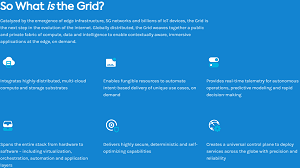News
VMware Part of New Effort to 'Rearchitect the Internet'
A new effort to "rearchitect the internet" includes major industry players VMware, Dell Technologies and others who will work on a major transformation with a rebuild focused on the edge.
Those companies, along with several others, are founding members of the Open Grid Alliance, on a mission "to evolve the internet to be a global, shared platform that distributes compute, data, and intelligence to when and where it's needed, on demand."
Today's internet isn't up to snuff, the group says, because it started at the core and worked outwards, providing less functionality in those remote edges.
As with many revolutionary movements, it's explained in a manifesto. The Open Grid Manifesto sums up the effort:
Most of what we consume on the internet today originates in a handful of massive data centers located, often, where land and power have been cheap. The applications housed in these data centers rely first on public and private backbones, and then the last mile networks, to carry their logic and data to the fringes, to the edge, where most of us exist and where they can deliver value.
This is the internet we have today. It evolved from the core out, growing naturally like a tree, spawning new limbs as its trunk got thicker and its branches reached farther.
Today, all the innovation is happening at the edge. We are moving from an era of humans talking to machines at the core into an era of machines talking to machines at the edge. We need a next-generation internet, built from the edge in.
The OGA's site explains that the grid in a graphic:
 [Click on image for larger view.] Explaining the Grid (source: Open Grid Alliance).
[Click on image for larger view.] Explaining the Grid (source: Open Grid Alliance).
A VMware post recapped the group's stated ambition:
- Begin by virtualizing the data center to build a logical pool of adaptive compute resources spanning multiple geographies.
- Compliment this by virtualizing the networking to make the network invisible to the user.
- Next, virtualize the edge, bringing together disparate providers in a compute grid that provides just the right level of compute, in the right place, at the right time, driven by the application intent.
- With the compute grid in place, take on the more interesting challenge of virtualizing the control to enable universal autonomy with an ‘intelligence grid', our ultimate ambition with the Open Grid.
The effort was announced by Vapor IO and VMware in an April 14 news release, which listed other founding members as Dell Technologies, DriveNets, MobiledgeX, and PacketFabric.
"The OGA will define key principles for the Open Grid and identify interoperable technologies that adhere to those principles," the release states. "It will document how these technologies will impact cloud providers, developers, vendors, communication service providers (CSPs), internet service providers (ISPs), and end users. The OGA will promote collaboration and open architectures that will enable the dynamic geo-distribution of workloads."
Vapor IO blogged about the OGA here, while VMware penned a separate post here.
Vapor IO's post stated: "In our view, the internet should behave like an electric grid. When a city or town demands more power, the electric grid can intelligently shift where electrons go. It can spin up generators to meet peak loads, then spin them down when no longer necessary. In the Open Grid world, when applications demand resources -- in a particular place, at a particular time, with particular SLAs -- the grid will deliver that, on demand.This is no small feat. It sounds like science fiction. But it's not. Not if we, as an industry, work together to make it happen."
About the Author
David Ramel is an editor and writer at Converge 360.